Haswell and GK110 vs. Ivy and GK104: DigitalStorm Virtue System Review
by Dustin Sklavos on June 23, 2013 12:00 PM ESTSystem and Gaming Performance
The two subjects we want to examine with the DigitalStorm Virtue and its 4.4GHz Intel Core i7-4770K are whether or not the overclocking plateau really has stayed level over the past two or three generations of Intel CPUs, and just how close GK104 can really get to GK110. Remember that the GeForce GTX 770 actually ships with memory clocks higher than most GTX 680s could attain, and memory bandwidth was frequently the bottleneck with GK104.
An important comparison to keep in mind: the 4.6GHz Intel Core i7-3770K is only clocked about 5% faster than the new 4.4GHz i7-4770K. Haswell tends to be roughly 10% faster clock per clock than Ivy, so with some dirty math it would take about a 4.8GHz i7-3770K to make up the performance gap.
As for the overclocked GTX 680 against the GTX 780, that's a bit trickier. The 780 is working with almost 50% more memory bandwidth, and with some extremely dirty math, about 20% more shader power. That's before you try to calculate the GTX 780's boost clocks, which are much jumpier than the GTX 680's. Even missing an entire SMX cluster, GK110 is still a bear compared to the more svelte GK104.
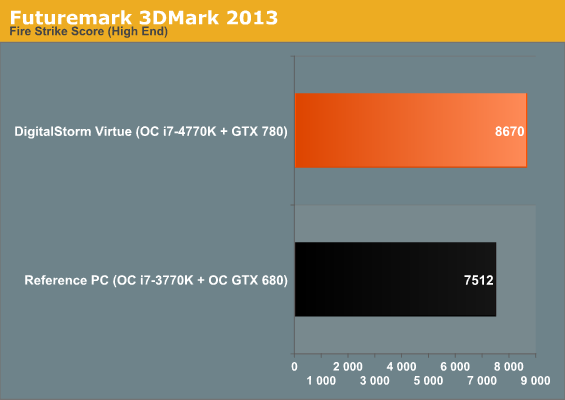
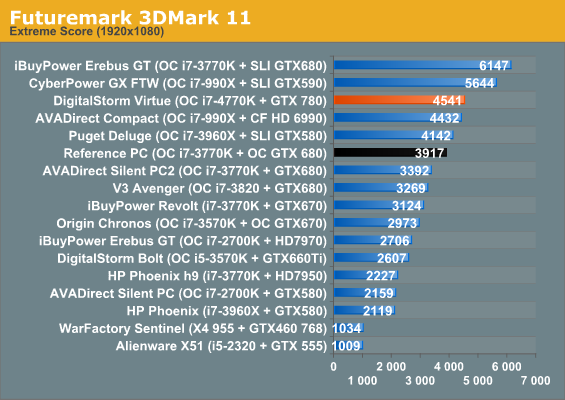
The 3DMarks pretty much tell the story. In both 3DMarks, a stock 780 is still ~15% faster than a heavily overclocked GTX 680.
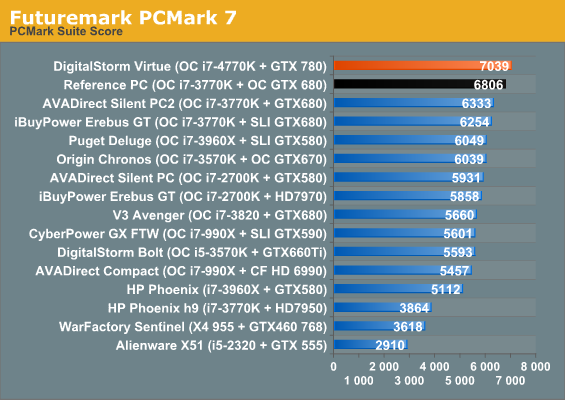
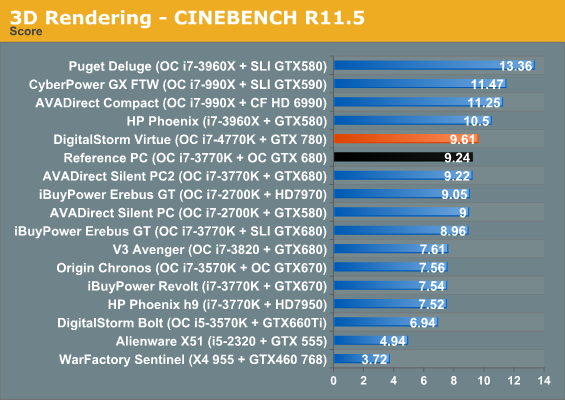
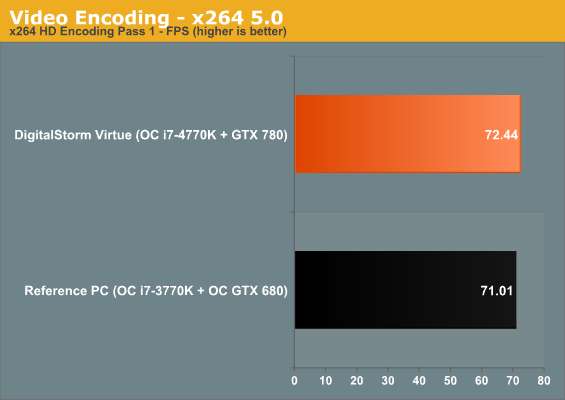
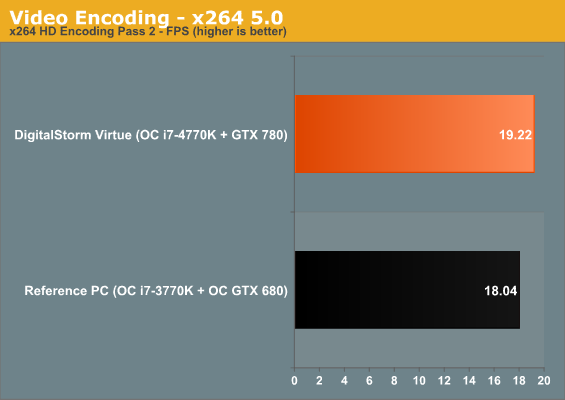
While PCMark7 tends to simply favor newer, faster SSDs, the difference between Haswell and Ivy gets a lot uglier when we isolate CPU performance. Consensus is that we've lost a bit of overclocking headroom with Haswell, making the comparison between a 4.6GHz Ivy and 4.4GHz Haswell a reasonably fair one. Cinebench is just 5% faster on Haswell, the first pass of the x264 benchmark is a dismal 2% faster on Haswell, and the second pass is at least a slightly healthier 7%.
Also note the improvement from Sandy to Ivy in Cinebench, though: our fastest Ivy is just 2% faster than our fastest Sandy. That Sandy was also running at 4.6GHz. Ivy at least brought a fat reduction in power consumption and TDP from Sandy despite the mediocre IPC improvement, but Haswell actually increased power consumption.
The math gets even uglier when we compare Sandy to Haswell. A 4.4GHz i7-4770K is only 6% faster than a 4.6GHz i7-2700K. That means that in two subsequent generations, the performance ceiling has barely moved. Anand is keen to point out that Intel's ability to eke out ~10% additional IPC on the same 22nm process node with a new architecture is impressive, and that may be true from a technical perspective, but Intel has offered enthusiasts virtually nothing new for two generations running. So whether or not the technical achievement is notable, end users are still left holding the bag. At this point, if you're hankering for more performance on the CPU, your best bet is actually to either go for an i7-3930K or wait for Ivy Bridge-E and hope Intel doesn't bone us with thermal paste instead of fluxless solder again. The only real selling point of Haswell, as far as I'm concerned, is access to the Z87 chipset.
Thankfully, while the jump in price from the NVIDIA GeForce GTX 680 to the GTX 780 isn't a particularly happy one, at least that dial moved pretty substantially. We tested every game at our Enthusiast settings (essentially maxed out and topping out at 4xMSAA), at 1920x1080 and then at 5760x1080.
|
GTX 680 1080p |
GTX 780 1080p |
% Perf. Increase |
GTX 680 Surround |
GTX 780 Surround |
% Perf. Increase |
|
| BioShock Infinite | 83.1 | 91.6 | 10.2% | 32.5 | 37.1 | 14.2% |
| Elder Scrolls V: Skyrim | 93.4 | 104.1 | 11.5% | 72.1 | 75.7 | 5% |
| GRID 2 | 87.3 | 109.2 | 25.1% | 39.4 | 49.2 | 24.9% |
| Metro: Last Light | 36.7 | 40.7 | 10.9% | 13.7 | 15.7 | 14.6% |
| Sleeping Dogs | 90 | 101.2 | 12.4% | |||
| StarCraft II: Heart of the Swarm | 73.5 | 86.2 | 17.3% | |||
| Tomb Raider | 64.3 | 72.5 | 12.8% | 31.8 | 36.5 | 14.8% |
So how do we interpret these results? First, excluding the outlying Skyrim surround results, even a diehard overclocked GTX 680 user can expect to net at least 10% more power from the GTX 780. Bumping up to 5760x1080 actually even lets the GTX 780 start to stretch its legs; while the 680 seems to be limited either by memory capacity or memory bandwidth, the 780's 384-bit memory bus and extra 1GB of GDDR5 do a solid job of picking up the slack.
Remember, too, that this is all before you overclock the 780. The consensus right now seems to be that the 780 has a very healthy amount of overclocking headroom, more than the 680 did, so if you're willing to sacrifice some power consumption and noise, you can theoretically push the 780 to Titan levels and even a bit beyond. At that point, it will pull away substantially from the 680 and by extension, the 770. I'm planning to do a custom liquid cooling review in the near future to get a grasp of just how far we can reasonably push a pair of GTX 780s, and given that I regularly see boost clocks of about 1GHz on them with just air cooling and no overclocking, I'm pretty optimistic.










70 Comments
View All Comments
HideOut - Sunday, June 23, 2013 - link
That 5ghz chip is also 220w part. Not even close to relevant to most reasonable pc users. It's a marketing gimmick.wumpus - Monday, June 24, 2013 - link
The computer in question has a 250W GPU and a 1000W power supply, there is no reason to veto a 220W CPU. While I think the Nvidia 780 is a "marketing gimick" (pretty much the same additional performance/cost), it seems to be a minority opinion on this site.MrSpadge - Monday, June 24, 2013 - link
That 220 W is the reason Intels dismisses such CPUs, as they'd hardly sell at all. How ever would be interested in such beasts is already covered with the current Ks and Extremes, including factory OC'ed builds.Klimax - Tuesday, June 25, 2013 - link
220W which won't beat my 3930k on conservative overclocking 4.4GHz and which is most likely cheaper...MrSpadge - Monday, June 24, 2013 - link
That's rubbish. Super low temperatures always help FETs to work significantly faster. That's why the clock speeds reached with LN2 will NEVER be possible in production untits of the same fundamental technology.And if Intel designed for significantly higher clock speeds they'd loose IPC due to the longer pipeline and would blow the power efficiency gains Intel worked so hard on during the last years completely out of the window. Just remember the Pentium 4 or nVidias hot clock versus Kepler.
Nintendo Maniac 64 - Sunday, June 23, 2013 - link
Contrary to what everyone is saying, I and several others have discovered that Haswell is surprising fast at emulation - around 20% faster than Ivy and 30% faster than Sandy. If would be great if a review site like Anand would actually benchmark such programs because they are heavily CPU-oriented and currently are one of if not the only compelling reason for Haswell and it'd be a shame if people missed that memo.This forum topic summarizes what I describe:
http://www.overclock.net/t/1402557/haswell-is-surp...
Sabresiberian - Sunday, June 23, 2013 - link
Yeah I agree from an enthusiast viewpoint that Haswell is a little underwhelming, and am irritated that Intel kept the glue-on method of attaching covers, but there are apps in which it crushes Ivy Bridge - and none in which Ivy Bridge is superior.As always, buy your hardware for the applications you most want to support. :)
JDG1980 - Sunday, June 23, 2013 - link
I agree that emulators could work well as CPU benchmarks, especially since many of them are single-threaded or lightly-threaded (so they're a real-world application where IPC is important).PCSX2 running Dragon Quest 8 would be a good benchmark. It uses two CPU threads (three if MTVU is enabled) and is very demanding, especially in busy scenes.
Gigaplex - Monday, June 24, 2013 - link
Running PCSX2 on potentially pirated games for a commercial review is legally dubious at best.p1esk - Sunday, June 23, 2013 - link
So what is exactly the value DigitalStorm brings to the table?It seems to me that they put together a few off the shelf components, and slightly bumped up the frequency. Is that all? If so, that's something anyone who reads this site can do themselves in an hour or less.
What I expect from a "boutique" computer builder is systems like the new Mac Pro, only where I can customize everything and anything.
Otherwise, no, they don't deserve extra $200-300 on top of Newegg BOM.